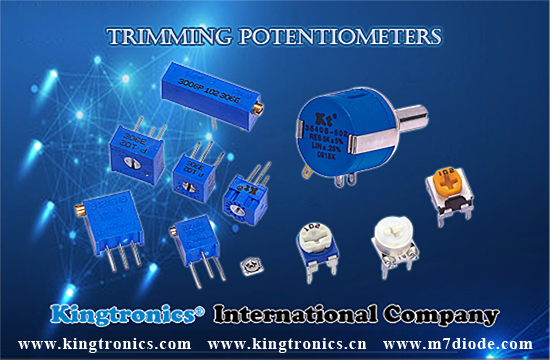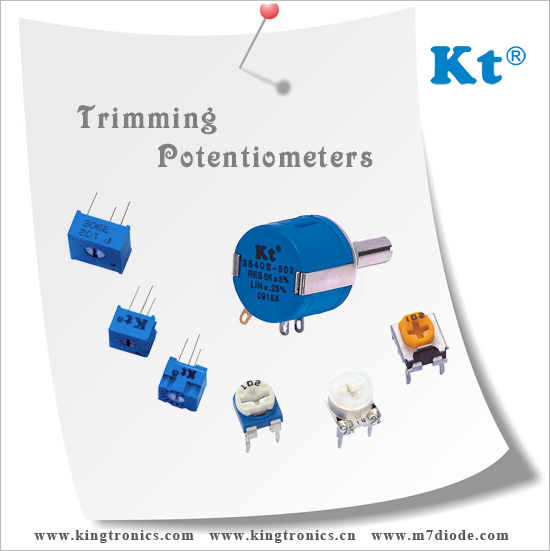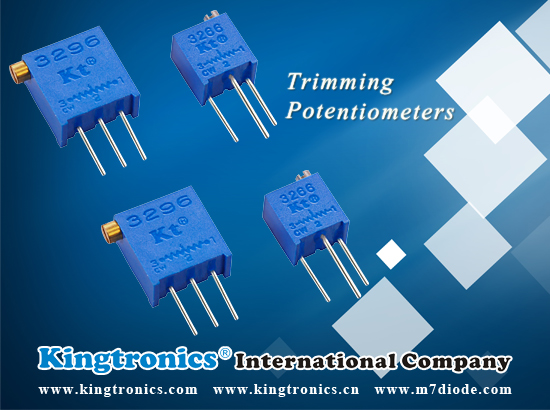For cermet trimming potentiometers, we offer competitive price, very speedy delivery ( mostly on stock), and very high quality. Do you want to try our price? Pls check our website: www.kingtromics.com and send inquiry. thanks.
- 0Commentary
- Tags:
Kingtronics trimming potentiometers perform a variety of circuit adjustments in all types of electronic equipment. Trimmers are used in virtually every electronic market. Typical applications include measuring linear distance, angles or rotations in production equipment, industrial test and measurement equipment, and medical equipment.
Kt Kingtronics Trimming Potentiometers Product List
1.RKT-3006 3/4" (19 mm) Rectangular Trimming Potentiometer
2.RKT-3266 1/4" (6 mm) Square Trimming Potentiometer
3.RKT-3296 3/8" (9 mm) Square Trimming Potentiometer
4.RKT-3299 3/8" (9 mm) Square Trimming Potentiometer
5.RKT-3323 1/4" (6 mm) Square Trimming Potentiometer
6.RKT-3329 1/4" (6 mm) Round Trimming Potentiometer
7.RKT-3362 1/4" (6 mm) Square Trimming Potentiometer
8.RKT-3386 3/8" (9 mm) Square Trimming Potentiometer
9.RKT-3306 6 mm Through-Hole Cermet Consumer Trimming Potentiometer
10.RKT-3309 9 mm Through-Hole Cermet Consumer Trimming Potentiometer
11.RKT-3361 1/4" (6 mm) Square SMD Trimming Potentiometer
12.RKT-3540S Precision Potentiometer (Multiturn)
13.RKT-3590 Precision Potentiometer (Multiturn)
- 0Commentary
- Tags:
Kt Kingtronics about Trimming Potentiometers
15 Apr 2011Trimming Potentiometers carry specifications for potentiometer category and actuator configuration. Industrial-grade potentiometers are protected by an enclosure, typically one that is rated by the National Electrical Manufacturers Association (NEMA). Typically, industrial-grade products are gear-driven and have connector outputs. These Trimming Potentiometers resist the ingress of dirt and dust, and last longer than unenclosed potentiometers. Discrete-board components, another potentiometer category, are also commonly available. In terms of actuator configuration, choices include single-turn, multi-turn, and slide. With single-turn devices, the shaft rotation is limited to less than or equal to 360 degrees. By contrast, multi-turn Trimming Potentiometers can be rotated multiple times, with as many as 15 or 20 turns from stop to stop. Slide-actuated products require the user to move a handle instead of rotating a knob.
Kt Kingtronics Membrane Potentiometer
29 Mar 2011A membrane potentiometer uses a conductive membrane that is deformed by a sliding element to contact a resistor voltage divider. Linearity can range from 0.5% to 5% depending on the material, design and manufacturing process. The repeat accuracy is typically between 0.1mm and 1.0mm with a theoretically infinite resolution. The service life of these types of potentiometers is typically 1 million to 20 million cycles depending on the materials used during manufacturing and the actuation method; contact and contactless (magnetic) methods are available. Many different material variations are available such as PET(foil), FR4, and Kapton. Membrane potentiometer manuafacturers offer linear, rotary, and application-specific variations. The linear versions can range from 9mm to 1000mm in length and the rotary versions range from 0° to 360°(multi-turn), with each having a height of 0.5mm. Membrane potentiometers can be used for position sensing.http://www.kingtronics.com/trimming-potentiometers/

One of the most common uses for modern low-power potentiometers is as audio control devices. Both linear potentiometers and rotary potentiometers are regularly used to adjust loudness, frequency attenuation and other characteristics of audio signals. The 'log pot' is used as the volume control in audio amplifiers, where it is also called an "audio taper pot", because the amplitude response of the human ear is also logarithmic. It ensures that, on a volume control marked 0 to 10, for example, a setting of 5 sounds half as loud as a setting of 10. There is also an anti-log pot or reverse audio taper which is simply the reverse of a logarithmic potentiometer. It is almost always used in a ganged configuration with a logarithmic potentiometer, for instance, in an audio balance control.
- 0Commentary
- Tags:
Transducers
Potentiometers are also very widely used as a part of displacement transducers because of the simplicity of construction and because they can give a large output signal.
Computation
In analog computers, high precision potentiometers are used to scale intermediate results by desired constant factors, or to set initial conditions for a calculation. A motor-driven potentiometer may be used as a function generator, using a non-linear resistance card to supply approximations to trigonometric functions. For example, the shaft rotation might represent an angle, and the voltage division ratio can be made proportional to the cosine of the angle.
- 0Commentary
- Tags:
Kingtronics About Trimming Potentiometers
25 Feb 2011Variable resistors used as potentiometers have all three terminals connected.

This arrangement is normally used to vary voltage, for example to set the switching point of a circuit with a sensor, or control the volume (loudness) in an amplifier circuit. If the terminals at the ends of the track are connected across the power supply then the wiper terminal will provide a voltage which can be varied from zero up to the maximum of the supply.
- 0Commentary
- Tags:
Kingtronics Trimming Potentiometer
12 Feb 2011Kingtronics is a manufacturer of Trimming Potentiometer. Trimming potentiometers are Kingtronics' first products. On Kingtronics' trimming potentiometers body, we mark "King" due to insufficient space. “Kingtronics” and "Kt" are our brand too. So, Kingtronics trimmers, Kingtronics potentiometers, King trimmers, and King potentiometers all mean potentiometers which produced by Kingtronics International Company.Our products are well crossed to Bourns Brand parts. We offer Kingtronics potentiometers (with Kt Mark trimming potentiometer) include following part number: RKT-3006, RKT-3266, RKT-3296, RKT-3299, RKT-3323, RKT-3329, RKT-3362, RKT-3386, RKT-3318, RKT-3306, RKT-3309, RKT-065, RKT-105H, RKT-C3305, RKT-3361, RKT-3540S, RKT-3590. Our trimming potentiometers are RoHS compliant.
Now Kingtronics offer Bourns equivalence. If you want more details , please visit website:www.kingtronics.com for full specification.
If you have any inquiry about Trimming Potentiometer , pls contact info@kingtronics.com.
Welcome to check our price!
- 0Commentary
- Tags:
The reliability of a potentiometer depends on its ability to continue performing its intended function. Since the primary function is to provide a continuous and proportional voltage output, the primary reliability considerations are continuity and proportional voltage output. A failure in continuity is always catastrophic, as the device is no longer acting as a potentiometer.
The primary constituents of continuity are:
Wiper contact to conductive surface
Continuous conductive surface
Wiper (output) and excitation terminal continuity

Dielectric Voltage Ratings of Potentiometer
15 Jan 2011Dielectric Voltage - The dielectric (insulation of Potentiometer "guts" to the body) rating is especially important if the Potentiometer is connected to mains operated, non-isolated equipment. Wall mounted lamp dimmers and such are typical examples. This is not commonly specified, but for safety, should be at least 2.5kV. A common way to achieve this is to use a plastic shaft, with the body of the Potentiometer insulated from the chassis, and inaccessible by the user - even if the knob falls off or is removed! This point cannot be stressed highly enough.
Most standard Potentiometer will safely withstand (maybe) 100V or so between the resistance element and terminals, and the body and shaft. Miniature types will usually be less than this. Never, ever, use a standard Potentiometer with a metal shaft to control direct mains operated equipment. Even if the Potentiometer case is earthed, the voltage rating between the internal element(s) and terminals to the case is often unspecified, and is almost always completely unsuited to mains voltages.
- 0Commentary
- Tags:
Contact us
Tel: (86) 769 8118 8110
Tel: (852) 8106 7033
Fax: (852) 8106 7099
E-mail: info@kingtronics.com
Skype: kingtronics.sales
Web: www.Kingtronics.com
YouTube: www.youtube.com/c/Kingtronicskt
About
Kingtronics International Company was established in 1995 located in Dongguan City of China to handle all sales & marketing for factories located in Chengdu, Sichuan and Zhaoqing, Guangdong, China. In 1990, we established the first factory to produce trimming potentiometer and in 1999 we built up new factory in Zhao Qing, Guangdong. Now with around 850 workers, Kingtronics produce trimming potentiometers, dipped tantalum capacitors, multilayer ceramic capacitors, and diode & bridge rectifier. We sell good quality under our brand Kingtronics, and Kt, King, Kingtronics are our three trademarks. All our products are RoHS compliant, and our bridge rectifier have UL approval. Please visit our Products page, you could please download all our PDF datasheet and find cross reference for our Trimming Potentiometer and capacitors.
Tantalum and Ceramic Capacitors Cross Reference ↓ Download
Diodes & Rectifiers List(PDF: 97KB) ↓ Download
Trimming Potentiometer Cross Reference ↓Download
Categories
- Kt Kingtronics (245)
- Diodes & Rectifiers (161)
- Aluminum Electrolytic Capacitor (161)
- Trimming Potentiometers (128)
- Tantalum Capacitors (96)
- Multilayer Ceramic Capacitors (70)
- Quartz Crystals (64)
- Kt Bridge Rectifier (64)
- Surge Arresters (34)
- Film Capacitors (34)
- Tactile Switches (32)
- Kt Kingtronics Components (30)
- Ceramic Trimmer Capacitors (26)
- Super Capacitors (18)
- Metal Oxide Varistor (12)
- Negative Temperature Coefficient Thermistor (6)
- Special Purpose Film Capacitors (3)
- Music capacitors (2)
Archives
- 2025 March (3)
- 2025 February (3)
- 2025 January (4)
- 2024 December (2)
- 2024 November (5)
- 2024 October (4)
- 2024 September (6)
- 2024 August (9)
- 2024 July (6)
- 2024 June (5)
- 2024 May (3)
- 2024 April (3)
- 2024 March (2)
- 2024 February (2)
- 2024 January (3)
- 2023 December (1)
- 2023 November (2)
- 2023 October (1)
- 2023 September (2)
- 2023 August (2)
- 2023 July (4)
- 2023 June (12)
- 2023 May (6)
- 2023 April (4)
- 2023 March (3)
- 2023 February (2)
- 2023 January (1)
- 2022 December (3)
- 2022 November (2)
- 2022 October (3)
- 2022 September (4)
- 2022 August (3)
- 2022 July (3)
- 2022 June (2)
- 2022 May (3)
- 2022 April (4)
- 2022 March (4)
- 2022 February (2)
- 2022 January (3)
- 2021 December (4)
- 2021 November (3)
- 2021 October (4)
- 2021 September (4)
- 2021 August (4)
- 2021 July (4)
- 2021 June (5)
- 2021 May (4)
- 2021 April (3)
- 2021 March (4)
- 2021 February (4)
- 2021 January (4)
- 2020 December (5)
- 2020 November (4)
- 2020 October (4)
- 2020 September (7)
- 2020 August (8)
- 2020 July (9)
- 2020 June (8)
- 2020 May (9)
- 2020 April (11)
- 2020 March (6)
- 2020 February (4)
- 2020 January (4)
- 2019 December (6)
- 2019 November (7)
- 2019 October (6)
- 2019 September (5)
- 2019 August (9)
- 2019 July (6)
- 2019 June (4)
- 2019 May (16)
- 2019 April (6)
- 2019 March (6)
- 2019 February (9)
- 2019 January (5)
- 2018 December (4)
- 2018 November (4)
- 2018 October (5)
- 2018 September (8)
- 2018 August (10)
- 2018 July (7)
- 2018 June (12)
- 2018 May (22)
- 2018 April (4)
- 2018 March (4)
- 2018 February (8)
- 2018 January (13)
- 2017 December (4)
- 2017 November (4)
- 2017 October (5)
- 2017 September (4)
- 2017 August (20)
- 2017 July (7)
- 2017 June (5)
- 2017 May (4)
- 2017 April (4)
- 2017 March (8)
- 2017 February (8)
- 2017 January (8)
- 2016 December (10)
- 2016 November (16)
- 2016 October (8)
- 2016 September (10)
- 2016 August (13)
- 2016 July (12)
- 2016 June (10)
- 2016 May (14)
- 2016 April (8)
- 2016 March (10)
- 2016 February (6)
- 2016 January (8)
- 2015 December (10)
- 2015 November (8)
- 2015 October (3)
- 2015 July (5)
- 2015 June (9)
- 2015 May (7)
- 2015 April (8)
- 2015 March (9)
- 2015 February (7)
- 2015 January (5)
- 2014 December (13)
- 2014 November (4)
- 2014 October (4)
- 2014 September (5)
- 2014 August (4)
- 2014 July (4)
- 2014 June (4)
- 2014 May (4)
- 2014 April (4)
- 2014 March (5)
- 2014 February (3)
- 2014 January (4)
- 2013 December (8)
- 2013 November (9)
- 2013 October (10)
- 2013 September (9)
- 2013 August (11)
- 2013 July (10)
- 2013 June (3)
- 2013 May (4)
- 2013 April (3)
- 2013 March (2)
- 2013 February (1)
- 2013 January (3)
- 2012 December (5)
- 2012 November (6)
- 2012 October (5)
- 2012 September (10)
- 2012 August (11)
- 2012 July (11)
- 2012 June (12)
- 2012 May (14)
- 2012 April (9)
- 2012 March (14)
- 2012 February (9)
- 2012 January (6)
- 2011 December (9)
- 2011 November (11)
- 2011 October (10)
- 2011 September (13)
- 2011 August (14)
- 2011 July (13)
- 2011 June (13)
- 2011 May (13)
- 2011 April (14)
- 2011 March (27)
- 2011 February (13)
- 2011 January (24)
- 2010 December (21)
- 2010 November (12)
- 2010 October (11)

